Key takeaways:
- Smart lighting systems enhance convenience, energy efficiency, and security, significantly improving daily life experiences.
- Key components include smart bulbs, sensors, a central hub, mobile apps, and voice assistants, all of which create a user-friendly experience.
- Future trends in smart lighting focus on AI integration, sustainable technology, and human-centric designs that improve mood and productivity.
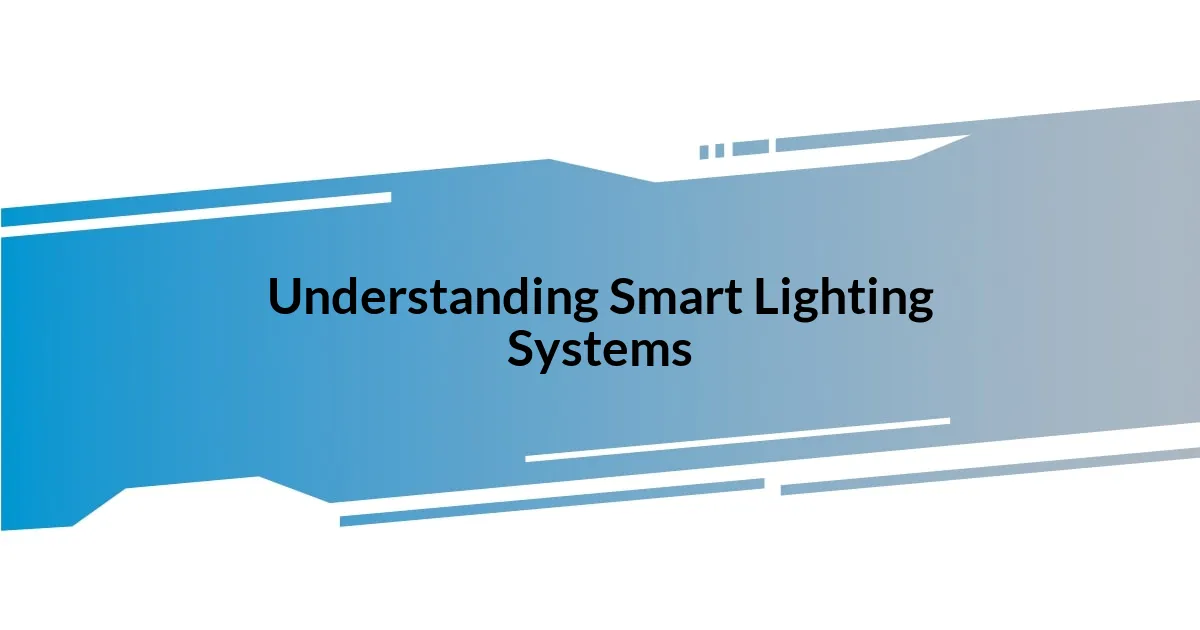
Understanding Smart Lighting Systems
Smart lighting systems are not just about turning lights on and off; they represent a leap towards more conscious and efficient living. I remember the first time I dimmed my living room lights using just my phone—it felt like being in an episode of a futuristic show. Can you imagine the convenience of controlling your entire home’s lighting from anywhere?
These systems work by integrating sensors, smart bulbs, and a central hub, allowing users to automate lighting based on their schedules or preferences. For instance, when I installed motion sensors in my hallway, I felt a sense of security knowing the lights would greet me without fumbling for switches in the dark. Isn’t it incredible how such a simple addition can enhance our daily lives?
Additionally, smart lighting can adapt to our moods and activities, changing the ambiance with just a voice command. Once, after a long day, I commanded my lights to shift to a warm, relaxing hue, and it instantly transformed my atmosphere. Have you ever thought about how lighting affects your emotions and productivity? There’s a profound connection here that can undoubtedly enhance our well-being.
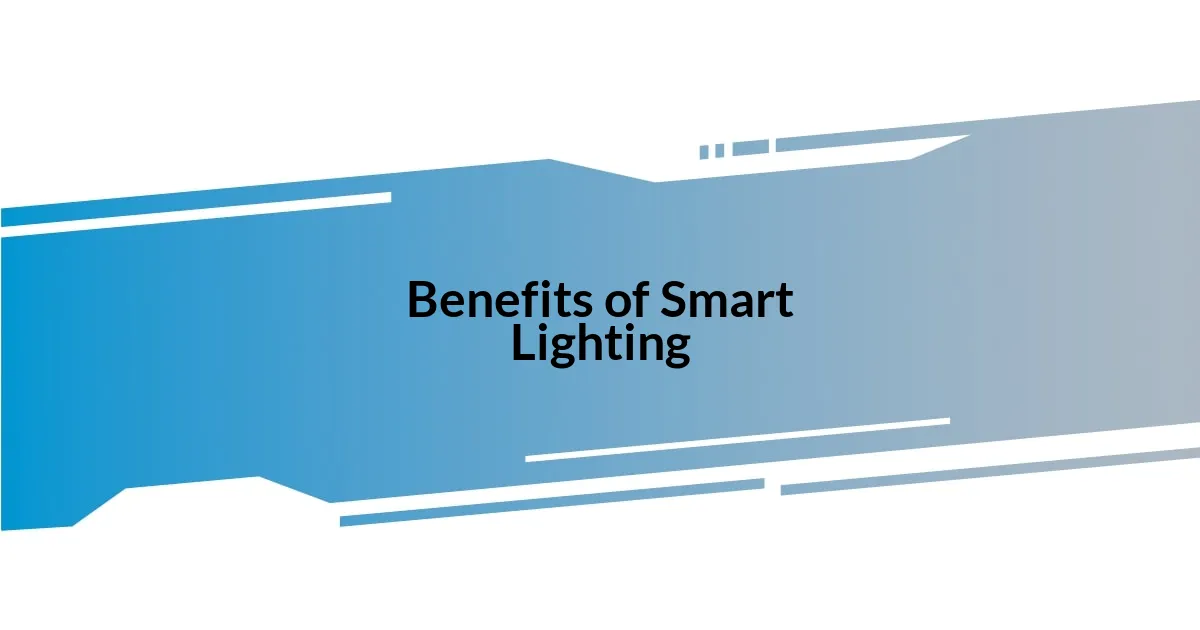
Benefits of Smart Lighting
Smart lighting systems bring an impressive array of benefits to our everyday lives. One major advantage is energy efficiency. By using sensors and smart controls, these systems can automatically turn off lights in unoccupied rooms, which I’ve found significantly cuts down on my electricity bills. Have you ever noticed how quickly those costs can spiral? With smart lighting, there’s less worry about wasting energy.
There’s also the enhanced convenience that comes with smart lighting. I remember attending a gathering at a friend’s house, and it struck me how easily they adjusted the lighting for different activities, like dinner or movie time, all with a simple voice command. It made me think—how often do we take lighting for granted? The ability to set the perfect mood with a few words is not only impressive but creates a more inviting atmosphere for gatherings.
Lastly, the security features of smart lighting systems can’t be overlooked. When I travel, I schedule my lights to mimic my usual patterns. It provides peace of mind, knowing that my home appears occupied to potential intruders. Have you considered how a well-lit home can deter unwanted guests? It’s comforting to know that enhancing my home’s lighting contributes to both safety and tranquility.
| Benefit | Description |
|---|---|
| Energy Efficiency | Reduces electricity usage with automated controls. |
| Convenience | Effortlessly adjust lighting for different activities with voice commands. |
| Enhanced Security | Simulates occupancy to deter potential intruders. |
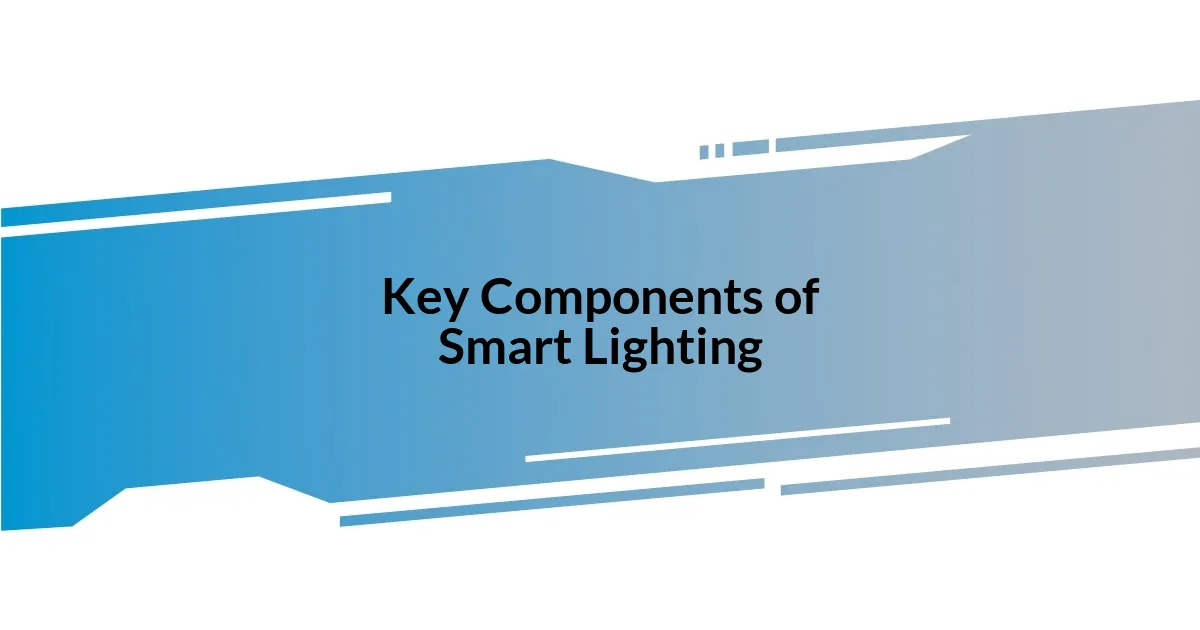
Key Components of Smart Lighting
Each element of a smart lighting system plays a vital role in creating that seamless experience I cherish. At the core, smart bulbs offer customizable brightness and color options, allowing me to set the perfect mood for any occasion. Recently, I experimented with color-changing bulbs during a movie night; I was reminded how a subtle hue can elevate the cinematic experience.
Here are the key components that make smart lighting systems function effectively:
- Smart Bulbs: These are energy-efficient and can change colors or dim, providing versatility in lighting.
- Sensors: Motion and ambient light sensors automatically adjust lighting based on presence and natural light levels.
- Central Hub: This acts as the brain of the system, connecting and controlling all devices through a single interface.
- Mobile App: It offers remote access and control, enabling adjustments from anywhere, even when I’m on the go.
- Voice Assistants: Integration with platforms like Amazon Alexa or Google Assistant allows for hands-free control, making my life even easier.
Each component intertwines to create an intelligent system that feels intuitive, supporting our daily routines and enhancing the ambiance in more ways than I initially imagined.
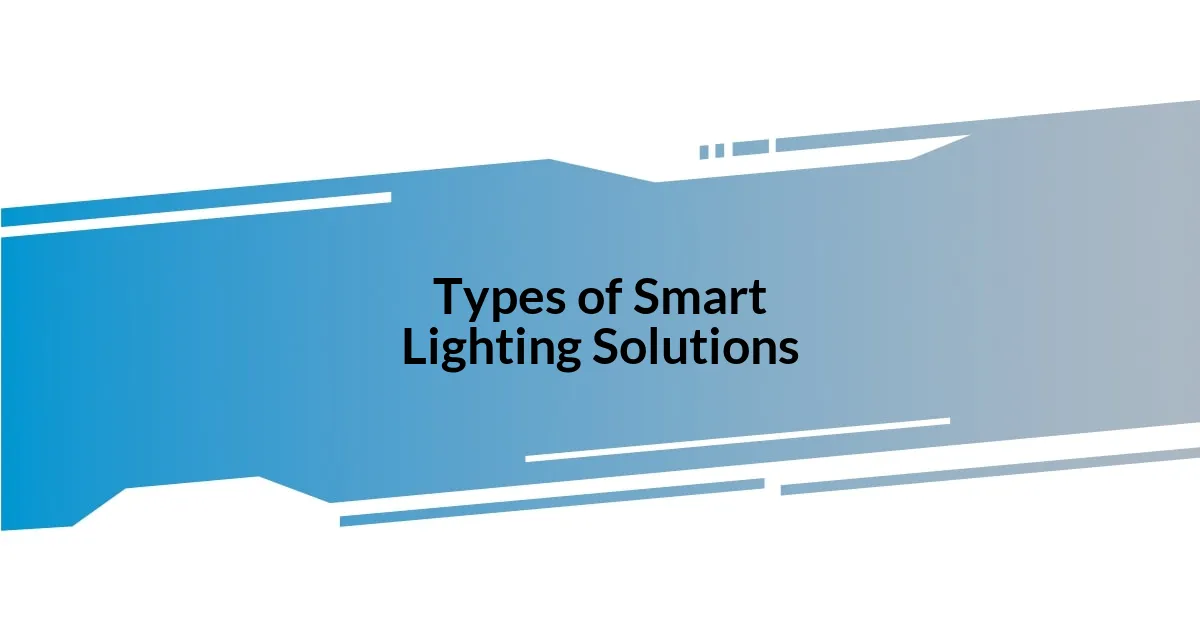
Types of Smart Lighting Solutions
There are several types of smart lighting solutions available, each offering unique features suited to different needs. One popular option is smart bulbs, which have become a staple in homes. I still recall the excitement of installing my first set of color-changing smart bulbs; the ability to shift the entire ambiance of a room with just a tap on my phone was almost magical. Have you ever experienced that moment when a simple change in lighting transforms your space completely?
Another innovative option is smart light strips, which can be placed under shelves or along walls to create stunning effects. I recently tried installing some in my home office, and the way they illuminated my workspace was incredible. The gentle glow kept me focused while giving the room a cozy vibe. Isn’t it fascinating how light can influence our productivity and mood so profoundly?
Then there are motion-sensor lights, which I find particularly useful for outdoor areas. When I’m out watering the garden in the evening, these lights flick on automatically, illuminating my path and creating a safe environment. Have you ever walked into a dark area and wished for a little extra light? With these smart solutions, that worry is behind me, making evenings spent outdoors much more enjoyable.
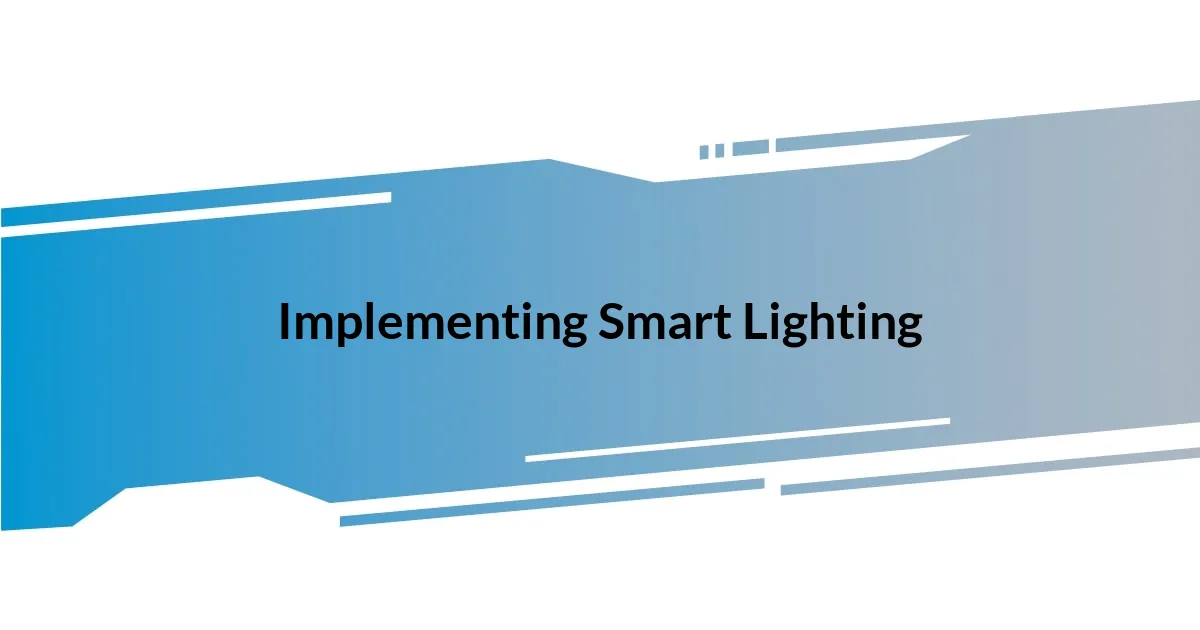
Implementing Smart Lighting
Implementing smart lighting in my home was an adventure in itself. The first step was setting up the central hub, which I initially found a bit daunting. But once I connected my smart devices, I felt a sense of accomplishment—like I had unlocked a new level of convenience in my daily life. Have you ever had that moment when everything just clicks into place? It was exhilarating.
Next, I dove into the mobile app, and wow, was it a game changer! Exploring the various settings felt like being a DJ at a party, tweaking the vibe just right with different light settings. I remember adjusting the lights to a calm blue while reading before bed; it transformed my evening routine into a much more relaxing experience. How often do we overlook how ambiance can enhance our daily rituals?
One of my favorite implementations has been the motion-sensor lights. I installed them in my hallway, and I can’t tell you how much easier they made my late-night trips to the kitchen. As I walked in the dark, the lights greeted me like an old friend, illuminating my path. It’s those little comforts—don’t you think they make a world of difference in our everyday life? Implementing smart lighting isn’t just about technology; it’s about creating an environment that enhances our well-being and convenience.

Enhancing Home Automation with Lighting
When I think about how lighting can elevate home automation, I can’t help but reminisce about those late evenings with friends. I set the mood with soft, dimmed lighting, and it instantly transformed our casual gathering into something special. Have you ever noticed how lighting creates a certain energy in a room? It’s almost like a conductor guiding the symphony of our interactions.
Another aspect I absolutely love is the ability to schedule my lights. One morning, I was pleasantly surprised when my bedroom lights gradually brightened, mimicking the sunrise. It was a gentle reminder to wake up, instead of the jarring sound of an alarm clock. Have you ever woken up feeling refreshed simply because of a well-timed light? That subtle shift in lighting really can make a world of difference, turning morning chaos into a smooth transition.
Integrating smart lighting with other home automation systems really maximizes convenience. For example, linking my lights to my security system means the moment I lock my front door, the outdoor lights activate. Not only does it enhance safety, but it also gives me peace of mind as I leave home. Isn’t it reassuring to know your home is looking out for you, even when you’re not there? Embracing smart lighting within home automation has truly reshaped how I experience comfort and security in my daily life.
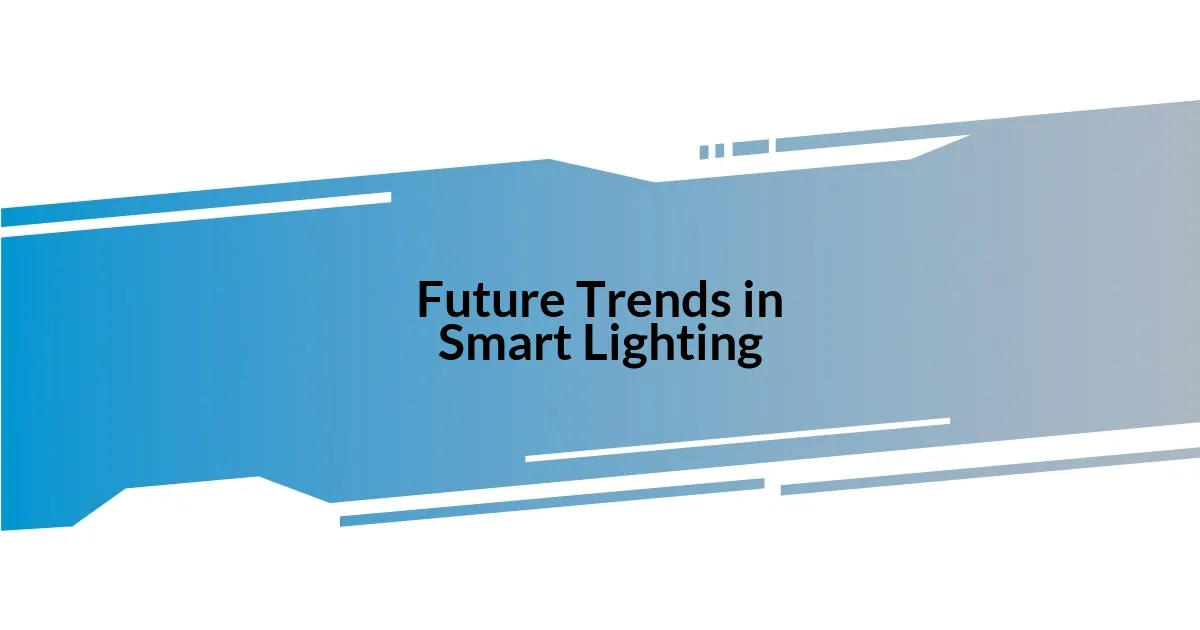
Future Trends in Smart Lighting
As I look ahead, the integration of artificial intelligence into smart lighting systems stands out to me. Imagine lights that learn our schedules and adjust automatically, creating optimal conditions without any input. I envision coming home after a long day, only to be greeted by perfectly adjusted lighting that feels warm and inviting, almost as if my home is embracing me. Isn’t it fascinating how technology can foster such personal connections with our spaces?
Another trend I’m excited about is the move towards sustainable lighting solutions. With growing awareness of environmental issues, I’ve noticed more brands focusing on energy-efficient technology. For instance, I recently switched to LED lights, and not only am I saving money on my electricity bill, but I also feel a sense of responsibility for minimizing my carbon footprint. Isn’t it empowering to know that small changes in our lighting choices can contribute to a more sustainable future?
Lastly, I’m intrigued by the concept of human-centric lighting, which emphasizes the impact of light on our mood and productivity. During my work-from-home days, I’ve experimented with different color temperatures to see what keeps me focused. I found that cooler lights in the morning helped me feel energized, while warmer hues in the evening calmed my mind. It raises an interesting question: how can we better utilize light to enhance our daily lives and well-being? Each discovery in this realm feels like unlocking a new layer of potential in our environments.